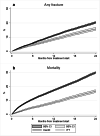Real-world effectiveness of osteoporosis treatment in the oldest old
- PMID: 32232509
- PMCID: PMC7360659
- DOI: 10.1007/s00198-020-05380-6
Real-world effectiveness of osteoporosis treatment in the oldest old
Abstract
We studied effectiveness of osteoporosis treatment in women older than 80 years, who often are not included in clinical trials. Treatments were as effective on bone density and fractures as in younger women.
Introduction: To study real-world effectiveness of osteoporosis treatment on BMD and fractures in the oldest old women (≥ 80 years) compared with women (60-79 years) in the clinical setting using Swedish health register data.
Methods: National registers and data from DXA machines were used to study effectiveness of all available osteoporosis treatments in women 60-79 and ≥ 80 years using three approaches: (1) Total Hip BMD change up to 8 years after treatment start; (2) fracture incidence where patients served as their own controls, comparing the first 3 months after treatment start with the subsequent 12 months; and (3) comparison of fracture incidence post-fracture in women ≥ 80 years treated with osteoporosis treatment or calcium/vitamin D.
Results: Analysis 1: Total Hip BMD increased by up to 6.7% and 7.7% in women 60-79 and ≥ 80 years old, respectively. The mean increase in BMD was 1.1%-units per year in both age groups. Analysis 2: Relative to the 3-month baseline, fracture incidence decreased during the subsequent 12 months of treatment. Incidence rate ratios were estimated at 0.65, 0.74, 0.29, and 0.81 for any, hip, vertebral, and non-hip-non-vertebral fracture, respectively. Analysis 3: A 24-month incidence of any fracture in women ≥ 80 years given post-fracture osteoporosis treatment was lower (HR = 0.78) than in women given calcium/vitamin D, but treatment allocation was not random, with lower mortality (HR = 0.51) in patients receiving OP treatment.
Conclusions: Osteoporosis medication in women > 80 years in clinical practice likely works, and the magnitude of effect is similar to what was estimated in younger women. The choice between osteoporosis treatment and calcium/vitamin D after fracture in women ≥ 80 years is not random but appears associated with the patient's health status and presence of vertebral fractures, rather than the known risk profile of sustaining a fracture at a high age.
Keywords: Bisphosphonates; Bone mineral density; Elderly; Register; Retrospective; Women.
Conflict of interest statement
OS, RL and GO are employed by Quantify Research, which has received consultancy fees from several pharmaceutical companies marketing osteoporosis drugs. KÅ has received lecture and consultancy fees from Amgen, UCB, Merck, Sandoz, Renapharma, and Eli Lilly. AS has received lecture fees from Amgen, Mylan and Eli Lilly. JO is employed by Amgen and is an Amgen stock owner. ÖL has no conflict of interest.
Figures
References
MeSH terms
Substances
LinkOut - more resources
Full Text Sources
Medical
Miscellaneous


